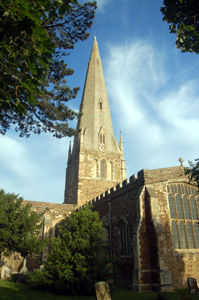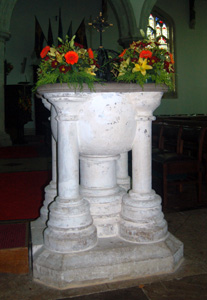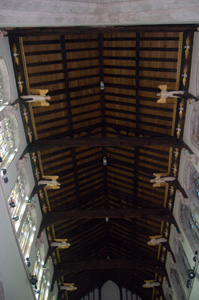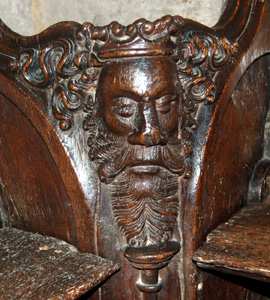
All Saints from the south-east June 2008
All Saints is a large church and its steeple can be seen for many miles. The Anglo-Saxon church formed part of the Diocese of Dorchester-on-Thames. From 1189 to 1852 Leighton Buzzard was a peculiar, in other words, it was exempt from the authority of the Archdeacon of Bedford as its rector (as opposed to the vicar, who, from 1276, acted as incumbent to the parish) was a prebend of Lincoln Cathedral.

Font October 2008
The previous church was demolished in the late 13th century when the current church was built. The only survivals are the early 13th century font and a small priest's bell of about 1150 (this survived the fire of 1985 when it fell from the burning tower onto the altar). Work on the new church began about 1277 and it was consecrated in 1288.

Nave roof looking west October 2008
The church is cruciform and comprises nave with aisles north and south, chancel, north and south transepts, crossing tower and massive spire. The clerestory and the angel roof of the nave were added in the 15th century at the expense of Lady of the Manor Alice de la Pole, Duchess of Suffolk in the late 1460s or early 1470s. At the same time the tracery in most of the windows was replaced by the Perpendicular work seen today.

King misericord - north choir stalls October 2008
Medieval work in the church includes choir stalls and misericords, it is not known where they originally came from. The rood screen is 15th century.

West door ironwork by Thomas of Leighton June 2008
Perhaps the most well known medieval things, however, are the wonderful 13th century ironwork on the west door and the graffiti. The ironwork is thought to be by Thomas of Leighton. He is known for his work on the tomb of Queen Eleanor, wife of Edward I, from exchequer accounts for 1293 recording the payment of £13 “to Master Thomas de Leghton, smith, for ironwork about the tomb of the Queen at Westminster, and for the carriage of the same from Leghton to London and the expenses of the said Thomas and his men dwelling in London to place the said ironwork about the tomb aforesaid”. Other examples of his work are thought to be in the churches at Eaton Bray and Turvey.